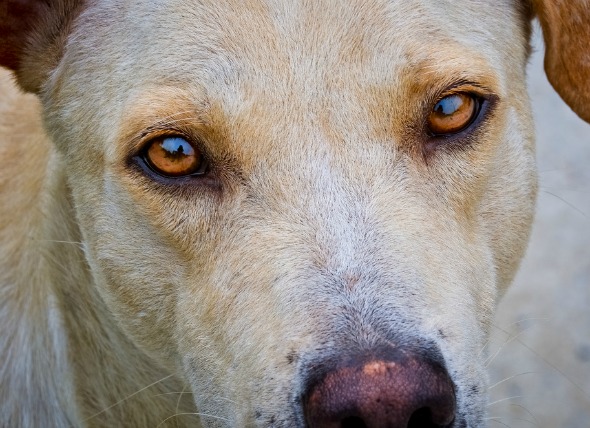

A tumor is defined as an abnormal growth of cells, and may be classified as primary or secondary. A primary brain tumor originates from cells normally found within the brain and its surrounding membranes. A secondary brain tumor, on the other hand, is either cancer that has spread to the brain (a process known as metastasis) from a primary tumor elsewhere in the body, or is a tumor that affects the brain by extending into brain tissue from an adjacent non-nervous system tissue, such as bone or the nasal cavity..
Dogs older than five years are more susceptible to developing brain tumors; the median age of affected pets is nine years. Certain breeds of dogs are at higher risk for developing primary brain tumors than others. Brain tumors that originate from the membranes covering the brain (known as meningiomas) are found more frequently in dolichocephalic breeds of dogs, which are characterized by long heads and noses, such as the Collie. Conversely, brachycephalic breeds of dogs, which are characterized by their short-nosed and flat-faced appearance, are more likely to develop gliomas, which are tumors of the interstitial tissue of the central nervous system.
The condition or disease described in this medical article can affect both dogs and cats. If you would like to learn more about how this disease affects cats, please visit this in the petMD health library.
The most common indication of a brain tumor in dogs is seizure, especially seizures that begin for the first time in a dog older than five years of age. Other signs suggestive of a brain tumor include abnormal behavior (e.g., increased aggression), altered consciousness, hypersensitivity to pain or touch in the neck area, vision problems, propulsive circling motions, uncoordinated movement, and a “drunken,” unsteady gait. Non-specific signs such as inappetance, lethargy, and inappropriate urination may also be seen.
The causes and risk factors that may cause brain tumors in dogs are unknown. It is speculated that various dietary, environmental, genetic, chemical, and immune system factors may be involved, but this is uncertain.
A tissue biopsy is the only available method for definitively diagnosing brain tumors in dogs. Imaging tests such as radiographs (x-rays) or ultrasound of other anatomical sites can be used to locate or to rule out primary tumors in other areas that may have spread to the brain. Magnetic resonance imaging (MRI) or computed tomography (CT) of the brain are the recommended tests for confirming the diagnosis of primary or secondary brain tumors.
There are three primary treatment options for for dogs that have been diagnosed with brain tumors: surgery, radiation therapy, and chemotherapy. The major objectives of these therapies are to eradicate, or reduce the size of, the tumor and to control secondary effects such as fluid build-up in the brain (known as cerebral edema). Surgery may be used to completely or partially remove tumors, while radiation therapy and chemotherapy may help to shrink tumors or reduce the chance of regrowth following surgery. Medications are also often prescribed to manage side effects of brain tumors, such as seizures.
During and after treatment, dogs with brain tumors should have routine physical exams that focus on their neurologic status. Repeat imaging with CT or MRI may be necessary. It is important to continually evaluate dogs for complications related to brain tumors such increased frequency of seizures, or aspiration pneumonia due to weakened swallowing reflexes associated with increased pressure of cerebrospinal fluid within the skull cavity. Lab work to monitor serum levels of anti-convulsant medications is routinely performed. The prognosis for dogs with brain tumors is guarded to fair. Survival times of 2-4 months are expected with supportive care alone, 6-12 months with surgery alone, 7-24 months with radiation therapy alone, 6 months to 3 years with surgery combined with radiation therapy, and 7-11 months with chemotherapy alone.
Due to the fact that the causes of brain tumors in dogs are unknown, it is difficult to establish any specific prevention methods.
Dr. Joanne Intile, DVM, DACVIM, reviewed and contributed to the content of this article.
 Long-Term Stomach Inflammation in Dogs
Chronic Gastritis in Dogs
Chronic gastritis is th
Long-Term Stomach Inflammation in Dogs
Chronic Gastritis in Dogs
Chronic gastritis is th
 Fainting in Dogs
Syncope in Dogs
Syncope is the clinical term for
Fainting in Dogs
Syncope in Dogs
Syncope is the clinical term for
 Chagas Disease in Dogs
American Trypanosomiasis Parasitic Infection in Dogs
&nb
Chagas Disease in Dogs
American Trypanosomiasis Parasitic Infection in Dogs
&nb
 Unintentional Eye Movement in Dogs
Nystagmus in Dogs
Nystagmus is a condition
Unintentional Eye Movement in Dogs
Nystagmus in Dogs
Nystagmus is a condition
 Parasite Drug (Ivermectin) Poisoning in Dogs
Ivermectin Toxicity in Dogs
This toxic reaction o
Parasite Drug (Ivermectin) Poisoning in Dogs
Ivermectin Toxicity in Dogs
This toxic reaction o
Copyright © 2005-2016 Pet Information All Rights Reserved
Contact us: www162date@outlook.com